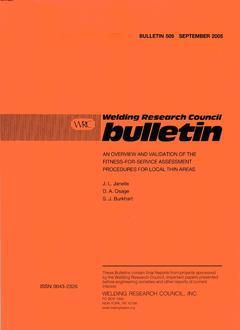Cart 0 Product Products (empty)
No products
To be determined Shipping
$0.00 Total
Product successfully added to your shopping cart
Quantity
Total
There are 0 items in your cart. There is 1 item in your cart.
Total products
Total shipping To be determined
Total
New Reduced price!  View larger
View larger
 View larger
View larger WRC 505
M00022864
New product
WRC 505 An Overview and Validation of the Fitness-For-Service Assessment Procedures for Local Thin Areas
Bulletin / Circular by Welding Research Council, Inc., 2005
J. Janelle, D. A. Osage, S. J. Burkhart
In stock
More info
Full Description
Most of the US design codes and standards for pressure containing equipment do not adequately address degradation and damage during operation. In the pressure vessel and pipeline industries, surface flaws are major limiting factors of vessel or pipe remaining life, and this type of degradation due to age and aggressive environment eventually threatens the structural integrity of equipment. Replacing vessel and piping equipment is expensive, making it cost effective and desirable to operate damaged pressurized equipment. For corrosion beyond a specified limit or other damage mechanism like cracking, a Fitness-For-Service (FFS) assessment is required.A FFS assessment is a quantitative engineering evaluation to determine the structural integrity of equipment containing a flaw or damage. The American Petroleum Institute (API) Recommended Practice (RP) 579 [1] is a comprehensive document for evaluating common flaws and damage in pressure vessels, piping, and tankage. The guidelines presented in API 579 may also be used in other industries as long as the applicability and limitations for an assessment are satisfied. API 579 is intended to supplement and expand upon the requirements in the inspection codes NBIC [2], API 510 [3], API 570 [4], and API 653 [5]. The goals are to ensure an acceptable margin of safety, provide accurate remaining life predictions, and help optimize maintenance and inspection for damaged equipment still in operation. The focus of this study is to further develop and validate the rules for assessing metal loss or corrosion damage in API 579.
The specific objectives reported in the bulletin are:Objective 1 Validate the API 579 Section 5 LTA rules in addition to the validation in WRC 465. Significant validation work was reported in WRC 465. After publication, additional burst pressure results became available. The validation now includes comparison of the API 579 methodology to other industry methods and to a database of full scale test results.Objective 2 Develop new or improve upon the existing methodology to increase the accuracy of the assessment procedures and eliminate some of the limitations. There are twenty-five different methods compiled in this study for analyzing local thin areas in pipes and vessels. These analysis methods all have roots in various industries, codes, and standards. In industry, at least five of these methods are actively used in Fitness-For-Service assessments today. This can make communication difficult between parties using different assessment procedures, and some parties may be using methods with low accuracy or reliability. Depending on the assessment code that is used, assessment results may vary drastically. One standardized set of analysis guidelines is needed to eliminate confusion regarding which method should be used. Objective 3 Standardize the in-service margin between MAWP and failure pressure for industry analysis methods and different construction code margins on allowable stress. The LTA assessment methods in API 579 may be used to evaluate equipment built to many different construction codes. Because the design margins in these codes are different, a method needs to be introduced that permits scaling of LTA assessment results such that a consistent in-service margin can be obtained based on the ratio of predicted burst pressure to the maximum allowable working pressure computed using the appropriate procedures in each construction code. Objective 4 Improve the existing rules for LTAs subject to supplemental loading (circumferential extent of the LTA). Significant improvements have been made to the original method contained in API 579 published in 2000. Objective 5 Introduce assessment procedures for the evaluation of HIC damage. An assessment method based on a remaining strength factor has been developed for sub-surface and surface breaking HIC damage. Objective 6 Introduce procedures for the evaluation of local metal loss in cylindrical shells subject to external pressure. This study represents a significant improvement to the current techniques available in the public domain for the analysis of Local Thin Areas. Information is also included that can be used to standardize the different LTA analysis techniques available in industry. However, further research, development and testing is required to further increase the accuracy of LTA analysis methods. The shortcomings of the assessment procedures are discussed as well as areas for future research.

